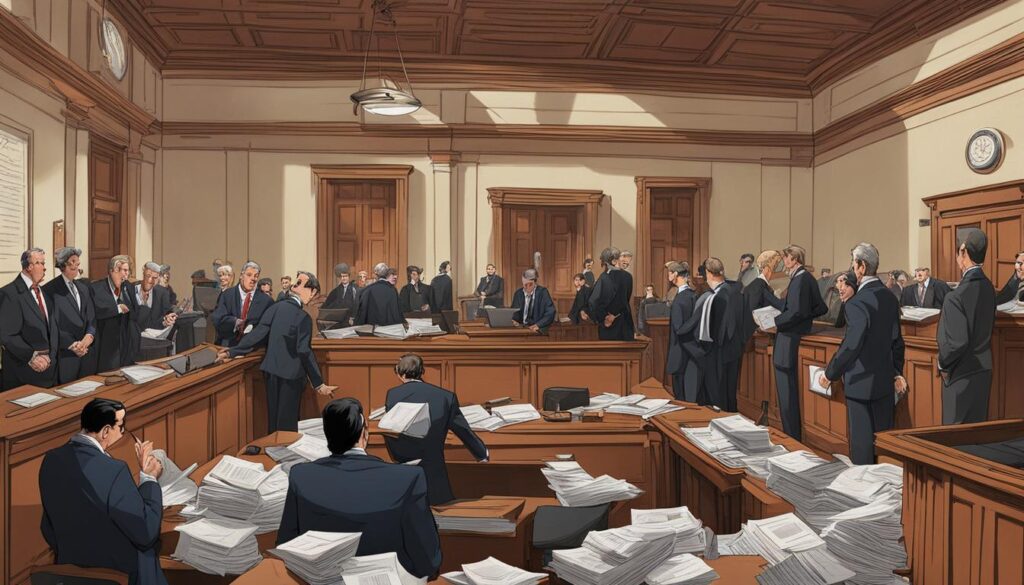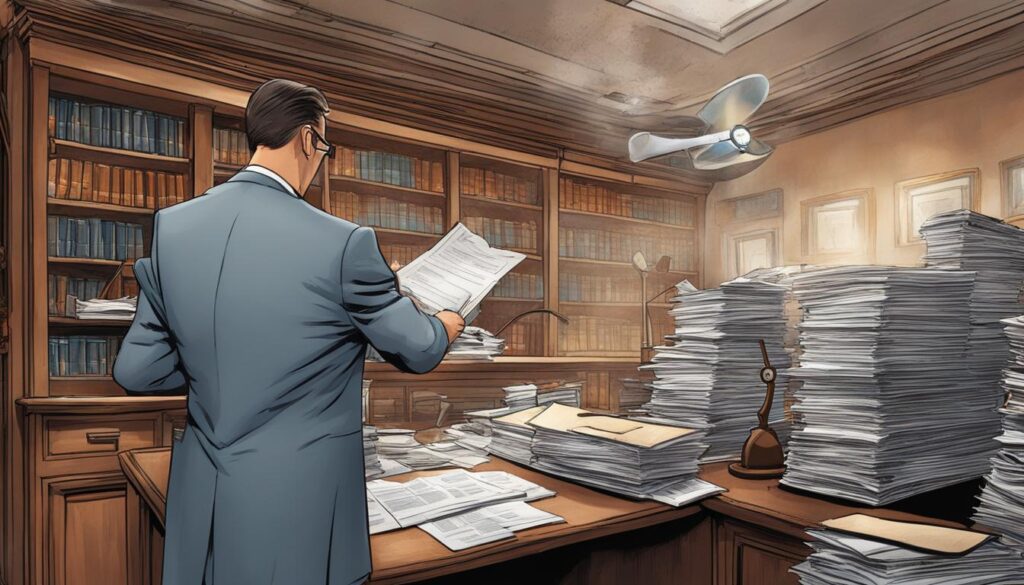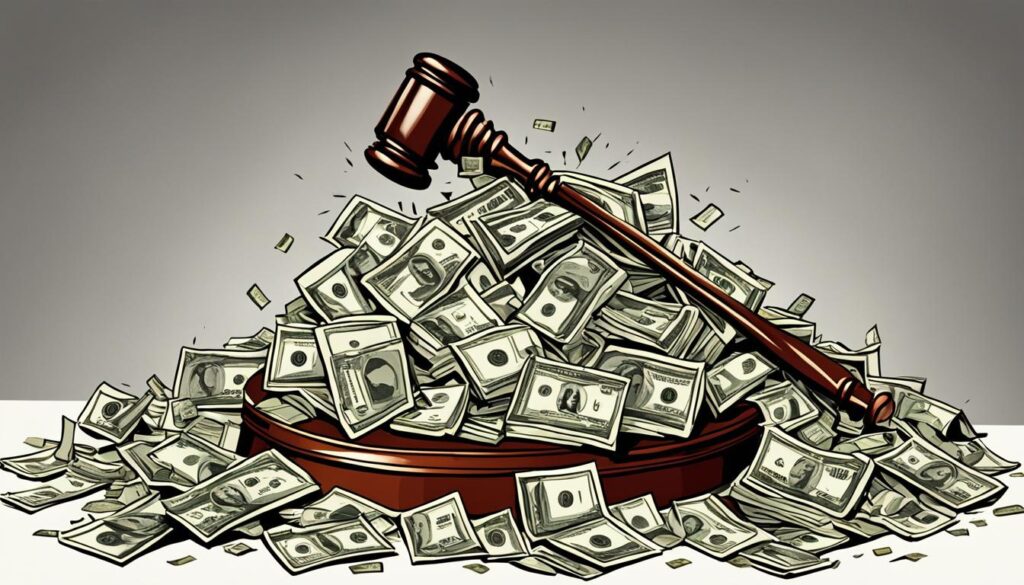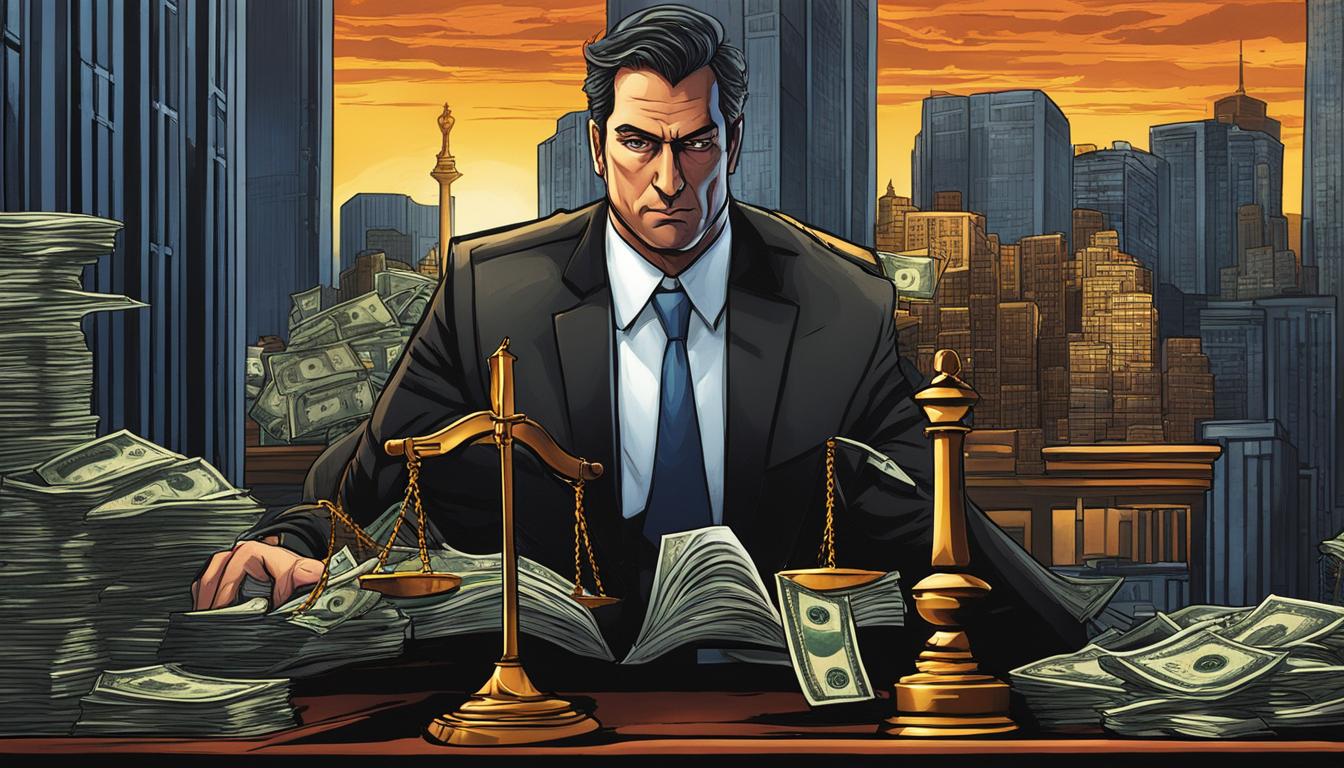The King of Torts, written by acclaimed author John Grisham, is a gripping legal thriller that delves into the dark side of the legal world. The story revolves around Clay Carter, a lawyer working for Washington D.C.’s Public Defense Office. Clay’s life takes an unexpected turn when he is presented with the opportunity to represent families affected by a pharmaceutical company’s crimes in a class-action lawsuit. What follows is a thrilling tale of ambition, wealth, and the consequences of Clay’s choices.
- The King of Torts is a legal thriller novel written by John Grisham.
- The story follows Clay Carter, a lawyer who becomes involved in a high-stakes class-action lawsuit.
- The novel explores themes such as the corrupt nature of the legal system and the consequences of greed.
- John Grisham’s writing style combines legal knowledge with thrilling narratives.
- The King of Torts was a bestseller and received positive reviews for its captivating plot and exploration of legal issues.
The Plot of The King of Torts
The King of Torts by John Grisham is a gripping legal thriller that delves into the world of Clay Carter, a public defender who reluctantly takes on a murder case. As Clay investigates further, he stumbles upon a scandal involving an experimental drug and a pharmaceutical company. Seizing the opportunity, Clay becomes the “King of Torts” by creating a mass tort and representing the affected families.
As Clay’s success grows, so does the scrutiny surrounding his actions. He faces questioning of his ethics and the consequences of his relentless pursuit of wealth. This thrilling novel explores the darker side of the legal world and the price one must pay for success.
Clay Carter’s Motivation and Relationships
Clay Carter, the protagonist of The King of Torts, is driven by a strong desire to escape his low-paying and unfulfilling job at the Washington D.C.’s Public Defense Office. Frustrated with his career, Clay longs for financial success and a better future.
While Clay is ambitious and determined, his pursuit of success strains his relationship with his girlfriend, Rebecca. The demands of Clay’s career often take precedence, leaving little time for their relationship to thrive. The tension between their personal lives and Clay’s professional aspirations becomes a significant source of conflict.
“I love Rebecca, but this career…it’s taking everything from us,” Clay mused, the weight of his decisions sinking in.
Complicating matters further, Clay faces disapproval and judgment from Rebecca’s parents, who hold reservations about their relationship and his chosen path. Their disapproval adds to Clay’s own doubts and insecurities as he struggles to balance his personal life with his newfound involvement in mass tort litigation.
As Clay delves deeper into the world of mass torts, his motivations and values undergo a transformation. The allure of wealth and success begins to overshadow his initial ideals. Clay finds himself questioning his own ethics and becoming increasingly driven by materialistic desires.
The Dark Stranger – Max Pace’s Offer
In The King of Torts, a pivotal moment in Clay Carter’s legal career occurs when he encounters a mysterious figure named Max Pace. Max, representing a pharmaceutical company, approaches Clay with an enticing proposition involving a class-action lawsuit and potential mass tort settlements. The objective of Max’s offer is to avoid the lawsuits going to trial and instead secure substantial settlements for the affected families.
Max becomes a significant presence in Clay’s life, leading him down a path of extravagant wealth and unparalleled success. However, as Clay navigates this newfound world of power and money, he realizes that the ethical line becomes increasingly blurred. The choices he makes in pursuit of financial gain have far-reaching consequences, and the dark stranger, Max Pace, serves as both catalyst and mentor in Clay’s transformation.
“The turning point in Clay’s career comes when Max Pace, a representative of a pharmaceutical company, offers him the chance to settle potential lawsuits in a class-action lawsuit.”
This critical turning point in the plot captures the allure and danger of the legal profession when driven by personal ambition and the pursuit of wealth. The interplay between Clay and Max sets the stage for a thrilling exploration of the moral and ethical complexities entwined within the world of mass tort litigation.
The Strategies and Tactics of Mass Tort Litigation
The King of Torts provides readers with a fascinating insight into the world of mass tort litigation and the intricate strategies employed by lawyers. Through the story of Clay Carter and his colleagues, John Grisham explores the multifaceted nature of class-action lawsuits and settlement negotiations.
- One of the key tactics used in mass tort litigation is the deployment of fear-driven TV commercials. Lawyers aim to reach potential clients affected by the harmful actions of pharmaceutical companies or other entities, urging them to join the lawsuit and seek justice for their grievances.
- Competition among lawyers is fierce when it comes to attracting clients for mass tort cases. The novel delves into the cutthroat nature of legal marketing, where lawyers employ various strategies to stand out and entice potential plaintiffs to join their class-action lawsuits.
- Negotiation of fees is another critical aspect of mass tort litigation. Lawyers involved in class-action lawsuits must determine their compensation while also ensuring the financial well-being of their clients. This delicate balance is explored throughout the novel, showcasing the complexities of fee negotiations in the world of mass torts.
- Tort operations committees play a significant role in mass tort litigation, particularly in coordinating the efforts of various lawyers and managing the overall strategy of the case. The inner workings of these committees, their decision-making processes, and their impact on the outcome of the litigation are central to the story.
“The King of Torts offers a gripping portrayal of the strategies and tactics employed in mass tort litigation. Grisham skillfully weaves these elements into the narrative, showcasing the fierce competition, high-stakes negotiations, and ethical dilemmas faced by lawyers in pursuit of justice and financial gain.”
Clay Carter and his fellow lawyers bask in their victories, enjoying lavish lifestyles funded by the substantial settlements they secure. However, their success does not go unnoticed. They face criticism from the traditional legal community and the media, raising questions about the ethics and consequences of mass tort litigation.

Clay Carter’s Transformation and Consequences
As Clay Carter’s success grows, his character undergoes a significant transformation. Initially a modest and fiscally conservative lawyer, Clay becomes consumed by greed and materialism. The allure of extravagant spending and newfound wealth leads him down a treacherous path.
Unfortunately, this path is not without its consequences. Clay’s past acts of kindness and alliances come back to haunt him as the justice system starts to scrutinize the foundations of his mass tort settlements. The repercussions of his actions begin to surface, jeopardizing everything he has achieved.
“With great power comes great responsibility,” as the saying goes. Clay’s rise to prominence in the world of mass torts raises important questions about legal ethics and the consequences of prioritizing personal gain over the well-being of those affected by mass torts.
Clay’s transformation serves as a cautionary tale about the potential pitfalls of pursuing wealth and success at any cost. It highlights the delicate balance between ambition and moral compass, shedding light on the ethical dilemmas faced by those navigating the legal profession.
The Impact on Clay’s Personal and Professional Life
Clay’s transformation not only affects his personal life but also has far-reaching repercussions in his professional career. As he indulges in a lavish lifestyle fueled by his newfound wealth, Clay’s relationships become strained, including his connection with his girlfriend, Rebecca. The pressures and demands of his career place a strain on their bond.
The consequences of Clay’s choices also extend beyond his personal circle. The justice system starts to question the validity and ethics of his settlements, casting doubt on the legitimacy of his success. Clay faces the risk of losing not only his wealth but also his credibility and professional standing.
Clay Carter’s Moral Journey
Clay’s transformation presents an opportunity for reflection on the ethical challenges faced by legal professionals. His journey serves as a reminder that success and wealth should not overshadow the importance of upholding legal ethics and acting in the best interests of those affected by mass torts.
Through the consequences that Clay experiences, the novel prompts readers to consider the ramifications of pursuing personal gain without considering the broader implications. It undoubtedly raises awareness about the need for legal professionals to prioritize the well-being of plaintiffs and maintain a strong moral compass.
The Backlash and Investigation
As Clay Carter’s mass tort settlements gain notoriety, they also attract the attention of the justice system. The dark side of some of his deals is exposed, putting him in the crosshairs of legal investigations. The media, as well as traditional trial lawyers, turn against him, creating a wave of backlash. Clay’s unethical practices become the target of an investigation, placing his reputation and career in jeopardy.
The consequences of Clay’s actions intensify as the FBI questions him on suspicion of insider trading. His past clients, once grateful for his representation, now feel betrayed and turn against him, filing malpractice lawsuits. The once celebrated “King of Torts” finds himself facing a legal and moral reckoning.

“Clay Carter’s sudden rise to legal stardom proves that even the most successful mass tort lawyer is not above the law. In his pursuit of wealth and fame, he crossed ethical boundaries, and now he must face the consequences.”
Clay’s downfall serves as a cautionary tale, shedding light on the far-reaching repercussions of mass tort litigation. The investigation into his practices exposes the inherent risks of prioritizing personal gain over justice and ethical conduct.
Clay Carter’s Downfall and Redemption
Clay’s journey in The King of Torts takes a dramatic turn as his actions catch up with him, leading to his inevitable downfall. As his career crumbles, he faces the loss of everything he once held dear – his wealth, his law license, and his assets. The consequences of his mass tort actions unravel before him, exposing the true extent of his greed and materialism.
However, amidst the ruins of his life, Clay discovers the possibility of redemption. Former friends and allies, who stood by his side during his rise as the “King of Torts,” resurface to offer support when he hits rock bottom. Their unwavering loyalty becomes Clay’s source of strength as he navigates through the darkest period of his life.
With nothing left to lose, Clay embraces the chance for redemption and takes a final gamble. Determined to atone for his past actions and expose the truth behind his settlements, he sets out on a journey to seek justice. This redemption arc brings Clay face to face with the consequences of his choices, paving the way for a compelling conclusion where the fate of his future hangs in the balance.
The Weight of Consequences
The downfall of Clay Carter serves as a cautionary tale, highlighting the repercussions of pursuing personal gain at the expense of others in the mass tort world. The consequences of Clay’s actions reverberate not only through his own life but also across the legal landscape. The novel offers a thought-provoking exploration of the moral and ethical complexities surrounding mass tort litigation, compelling readers to reflect on the potential pitfalls and fallouts of such endeavors.
“The path to redemption is often paved with the consequences of our choices.” – Author Unknown
A Moral Journey of Redemption
Clay’s redemption arc in The King of Torts sheds light on the transformative power of introspection and accountability. Through his pursuit of justice and the exposure of the truth, Clay begins to rebuild his integrity and search for personal redemption. His journey confronts important questions about personal values, ethics, and the potential for change even in the face of irreversible mistakes.
The intricately woven storyline of Clay Carter’s downfall and redemption serves as a poignant reminder of the impact our choices can have, not only on our own lives but also on those around us. It prompts readers to examine their own moral compass and contemplate the potential for redemption in the face of adversity.
The Themes Explored in The King of Torts
The King of Torts delves into several thought-provoking themes that shed light on the corrupt nature of the legal system, moral dilemmas faced by lawyers, the consequences of greed and ambition, and the importance of loyalty and redemption.
The novel serves as a powerful exploration of the legal world, inviting readers to contemplate the choices individuals make within it. Throughout the story, the author, John Grisham, navigates the complexities of the legal system, portraying its darker aspects and raising crucial questions about the pursuit of justice.
One of the primary themes in the book is the corrupt nature of the legal system. Grisham skillfully exposes the underbelly of the industry, revealing how power, money, and influence can manipulate the course of justice. The novel highlights the ethical challenges faced by lawyers, illustrating the constant moral dilemma they encounter as they balance their duty to their clients with their personal integrity.
“The practice of law is not something you master; it’s something you live with.”
Another theme explored is the consequences of greed and ambition. Through the character of Clay Carter, the “King of Torts” himself, Grisham illustrates the allure and pitfalls of striving for material success at any cost. The novel shows how Clay’s unrelenting pursuit of wealth and status leads to personal and professional downfall.
Loyalty and redemption also emerge as significant themes in the book. The story examines the impact of loyalty among friends and allies, as some stand by Clay Carter during his darkest moments. Ultimately, the novel emphasizes the potential for redemption, even in the face of seemingly insurmountable challenges.

The themes explored in The King of Torts resonate with readers as they shine a light on the flaws and complexities of the legal system, provoking contemplation about the moral choices that shape our society.
John Grisham’s Writing Style
John Grisham is renowned for his exceptional writing style that captivates readers from the very first page. In The King of Torts, Grisham demonstrates his mastery of crafting gripping and fast-paced narratives that keep readers on the edge of their seats.
Throughout the novel, Grisham’s storytelling prowess shines through, as he expertly weaves together suspenseful plotlines and well-developed characters. The pages practically turn themselves as readers become engrossed in the intricate web of legal thrillers.
What sets Grisham apart is his ability to offer readers an inside look into the legal world, drawing on his own experience as a lawyer. By incorporating his legal knowledge into the narrative, Grisham adds an additional layer of authenticity and detail that enhances the reading experience.
Grisham’s writing style exhibits a perfect balance between legal intricacies and thrilling narratives. He effortlessly combines courtroom drama, complex legal procedures, and suspenseful twists, resulting in page-turners that keep readers hooked until the very end.
The King of Torts is a prime example of Grisham’s ability to create compelling stories that resonate with readers. With its blend of legal expertise, high-stakes drama, and unexpected plot twists, this novel showcases why Grisham is considered one of the best authors in the legal thriller genre.
Experience John Grisham’s captivating writing style and immerse yourself in the world of legal thrillers by diving into The King of Torts.
The Success of The King of Torts
The King of Torts, written by John Grisham, quickly rose to success and became a bestseller shortly after its release. It made its debut at #1 on The New York Times Best Seller list, capturing readers’ attention with its thrilling plot and exploration of legal issues.
Remaining in the top 15 for over 20 weeks, The King of Torts received rave reviews for its captivating narrative and high-stakes drama. Grisham’s fans, as well as enthusiasts of legal thrillers, were drawn to the novel’s intense storyline, which kept them engaged from start to finish.
“John Grisham has done it again! The King of Torts is a suspenseful masterpiece that delves deep into the complexities of the legal world. It kept me on the edge of my seat throughout, making it impossible to put down.” – Book Review
Grisham’s ability to blend legal expertise with an enthralling narrative is once again showcased in The King of Torts. The novel’s success further solidifies Grisham’s reputation as a master of the legal thriller genre.
Other Works by John Grisham
John Grisham, acclaimed for his legal thrillers, has an extensive bibliography that spans multiple best-selling novels. In addition to The King of Torts, some of Grisham’s other notable works include:
- The Firm: A legal thriller centered around a Harvard Law School graduate who finds himself caught up in a dangerous conspiracy.
- The Pelican Brief: A young law student becomes the target of powerful political figures after uncovering a dangerous secret.
- The Rainmaker: A struggling lawyer takes on a high-profile insurance case involving a terminally ill young man.
- A Time to Kill: A gripping courtroom drama that explores themes of justice and racial tension in the Deep South.
Grisham’s books consistently delve into the intricacies of the legal system, challenging readers to consider the blurred lines between right and wrong, and the consequences of corruption. His ability to craft compelling narratives has earned him a devoted readership and made him one of the most successful authors of our time.
Conclusion
The King of Torts by John Grisham takes readers on a thrilling and thought-provoking journey into the world of class-action lawsuits and mass torts. Through the gripping story of Clay Carter, the novel explores the consequences of unchecked greed, the intricate workings of the legal system, and the significance of personal integrity.
The book serves as a reminder of the power and ethical dilemmas faced by those in the legal profession. It raises important questions about the pursuit of wealth and success at the expense of others, highlighting the need for accountability and ethical responsibility.
With his trademark writing style and insider knowledge of the legal world, Grisham delivers a page-turning experience that keeps readers engaged from beginning to end. The King of Torts is a must-read for fans of legal thrillers and anyone interested in the complexities of the justice system.
FAQ
What is The King of Torts about?
The King of Torts is a legal thriller novel written by John Grisham. It follows the story of Clay Carter, a public defender who becomes involved in a mass tort lawsuit against a pharmaceutical company.
Who is the author of The King of Torts?
The King of Torts is written by John Grisham, a popular author known for his legal thrillers.
What are some other notable works by John Grisham?
Some other notable works by John Grisham include The Firm, The Pelican Brief, The Rainmaker, and A Time to Kill.
What themes are explored in The King of Torts?
The King of Torts explores themes such as the corrupt nature of the legal system, moral dilemmas faced by lawyers, the consequences of greed and ambition, and the importance of loyalty and redemption.
What is John Grisham’s writing style like?
John Grisham is known for his gripping and fast-paced storytelling. His writing combines legal knowledge with thrilling narratives that keep readers engaged from start to finish.
How successful is The King of Torts?
The King of Torts was an instant success, debuting at #1 on The New York Times Best Seller list and remaining in the top 15 for over 20 weeks.
What can readers expect from The King of Torts?
The King of Torts offers readers a thrilling and eye-opening glimpse into the world of class-action lawsuits and mass torts. It explores the consequences of greed, the complexities of the legal system, and the importance of personal integrity.
What is the plot of The King of Torts?
The plot of The King of Torts revolves around Clay Carter, a public defender who takes on a high-profile case involving a pharmaceutical company’s crimes. As he delves deeper into the case, he becomes known as the “King of Torts” and faces the consequences of his actions.
How does Clay Carter’s transformation impact the story?
Clay Carter’s involvement in the mass torts leads to a shift in his personality and values. He goes from being a modest and conservative lawyer to a greedy and materialistic individual, which ultimately leads to personal and professional consequences.
What is the significance of Max Pace’s offer in the story?
Max Pace, a representative of a pharmaceutical company, offers Clay Carter the chance to settle potential lawsuits in a class-action lawsuit. This opportunity leads Clay down a path of wealth and success, but it also raises ethical questions and sets the stage for his downfall.
How does The King of Torts explore the strategies of mass tort litigation?
The novel delves into the strategies used in mass tort litigation, including fear-driven TV commercials, competition among lawyers to attract clients, negotiation of fees, and the inner workings of tort operations committees.
What is the outcome of Clay Carter’s downfall and redemption?
Clay Carter loses everything – his wealth, his law license, and his assets – as his actions catch up with him. However, he finds redemption in the support of former friends and allies who stand by him. He takes a final gamble to expose the truth behind his settlements and seek justice.
What does The King of Torts reveal about the legal system?
The King of Torts sheds light on the corrupt nature of the legal system and the moral dilemmas faced by lawyers. It also showcases the consequences of greed and ambition within the legal profession.
How does The King of Torts explore the consequences of mass tort litigation?
The novel depicts the backlash faced by Clay Carter and his fellow lawyers, including scrutiny from the traditional legal community and the media. It also highlights the investigation into their practices, including allegations of insider trading and malpractice lawsuits from disgruntled clients.



